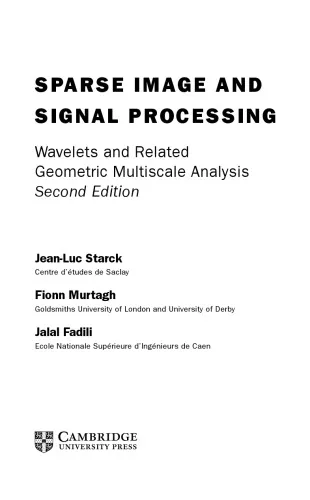Sparse Image and Signal Processing: Wavelets and Related Geometric Multiscale Analysis
4.3
بر اساس نظر کاربران

شما میتونید سوالاتتون در باره کتاب رو از هوش مصنوعیش بعد از ورود بپرسید
هر دانلود یا پرسش از هوش مصنوعی 2 امتیاز لازم دارد، برای بدست آوردن امتیاز رایگان، به صفحه ی راهنمای امتیازات سر بزنید و یک سری کار ارزشمند انجام بدینمعرفی کتاب: Sparse Image and Signal Processing
کتاب "Sparse Image and Signal Processing: Wavelets and Related Geometric Multiscale Analysis" یک منبع کلیدی و جامع در زمینه پردازش سیگنال و تصویر است که بر پایه مفاهیم sparsity یا تنک بودن و تکنیکهای تحلیلی مانند Wavelets و مدلهای چندفراگیر هندسی بنا شده است. این کتاب که توسط Jean-Luc Starck، Fionn Murtagh، و Jalal Fadili نوشته شده است، یکی از منابع اصلی برای پژوهشگران، دانشجویان و مهندسانی است که به دنبال درک عمیق از روشهای مدرن پردازش تصاویر و سیگنالها هستند.
خلاصهای جامع از کتاب
این کتاب اصول پایهای و پیشرفته تحلیل سیگنال و تصویر را با تمرکز بر sparsity ارائه میدهد. Wavelets، Curvelets و دیگر ابزارهای چندفراگیر (multiscale) در این کتاب بهطور دقیق توضیح داده شدهاند و مفاهیم تئوریک و کاربردهای عملی آنها بررسی میشود. از موضوعات اصلی پوشش دادهشده در کتاب میتوان به راهحلهای بازسازی تصویر، کاهش نویز (denoising)، فشردهسازی دادهها و روشهای بهینهسازی برای مشکلات ill-posed اشاره کرد.
در بخشهای مقدماتی، نویسندگان مبانی مدلسازی sparse را همراه با کاربردهای آن در زمینههای مختلف معرفی میکنند. سپس به بررسی جزئیات مفهومی Wavelets و خانواده بزرگتری از ابزارهای چندگانه تحلیل هندسی پرداخته میشود. این کتاب همچنین تمرکز ویژهای بر الگوریتمهای عددی و تکنیکهای بهینهسازی دارد که بهطور گسترده در کاربردهای مدرن علم داده استفاده میشوند.
نکات کلیدی یادگیری از کتاب
- فهم عمق مفاهیم sparsity و دلایل اهمیت مدلهای تنک در پردازش دادهها.
- یادگیری ساختار و کاربردهای Wavelets و Curvelets در آنالیز چندفاز.
- کاربرد تئوری sparse در کاهش نویز، آشکارسازی ویژگیها و بازسازی تصاویر.
- مطالعه الگوریتمهای کاربردی برای حل مسائل optimization مرتبط با sparsity.
- درک چگونگی ارتباط پردازش سیگنال، آمار و یادگیری ماشین در حوزه تحلیل تصاویر.
جملات معروف از کتاب
"In the age of big data, sparsity plays a key role in extracting meaningful and interpretable patterns from high-dimensional information."
"Wavelet transforms not only facilitate better data representation but also bridge the gap between theory and efficient practical implementation."
چرا این کتاب اهمیت دارد؟
این کتاب بهدلیل جامعیت و ساختار مدون آن یکی از آثار برجسته در حوزه پردازش سیگنال و تصویر است. ادغام مفاهیم تئوریک با کاربردهای عملی در حوزههایی همچون پردازش پزشکی، سنجش از دور، شناسایی چهره و دادهکاوی از دیگر نقاط قوت این کتاب محسوب میشود. تکنیکهای ارائهشده در این کتاب، از جمله استفاده از Wavelets و بهینهسازی sparse، به عنوان ستونهایی اساسی در بسیاری از زمینههای علمی و مهندسی شناخته میشوند.
علاوه بر این، این کتاب یک مرجع ارزشمند برای یادگیرندگان تمامی سطوح محسوب میشود، چرا که در کنار جنبههای ریاضی و تئوریک، نکات کاربردی و آموزشهای عملی برای استفاده از الگوریتمها و روشها را ارائه میکند. بهویژه، برای کسانی که در حوزههای یادگیری ماشین، آمار محاسباتی و علوم داده فعالیت میکنند، این کتاب میتواند به عنوان یک راهنمای کاربردی و موثر باشد.
در نهایت، رویکرد چندرشتهای و بینرشتهای این اثر باعث میشود که نهتنها برای متخصصان پردازش تصویر، بلکه برای محققان در علوم پایه، فیزیک و مهندسی نیز منبعی بسیار ارزشمند باشد.
Introduction to "Sparse Image and Signal Processing: Wavelets and Related Geometric Multiscale Analysis"
Welcome to the cutting-edge world of signal and image processing, where mathematics, algorithms, and practical applications converge. "Sparse Image and Signal Processing: Wavelets and Related Geometric Multiscale Analysis" is a comprehensive resource for researchers, engineers, and applied scientists alike. This book explores the revolutionary framework of sparsity, empowering readers to understand and solve modern challenges in image and signal representation with precision and computational efficiency.
Written by Jean-Luc Starck, Fionn Murtagh, and Jalal Fadili, this book is a cornerstone in the study of sparse approximation, offering both theoretical depth and a wide spectrum of practical examples. It sheds light on how the intrinsic structure of data can be exploited for better compression, denoising, and various other applications within the realm of signal and image processing. Here, we provide an overview of what this book delivers, its key takeaways, memorable moments, and why it is an essential addition to scientific literature.
1. Detailed Summary of the Book
The book is structured around building blocks of sparse representation and its applications within multiscale geometric frameworks, especially using wavelets.
It begins by introducing the mathematical foundations of sparse signal representations. Core topics like optimization techniques, wavelet transforms, and the theory of compressed sensing are explained rigorously yet intuitively. Building on these foundations, the authors delve into real-world applications, including image enhancement, noise reduction, and natural signal compression.
A notable strength of the book lies in its exploration of the interplay between sparsity and wavelets. Traditional image and signal processing methods often fall short in capturing complex geometrical structures, but the book demonstrates how multiscale representations, such as curvelets and ridgelets, effectively address these challenges. These methods provide sparse descriptions that can capture features such as edges, textures, and patterns with remarkable accuracy.
The text also touches on state-of-the-art topics like Bayesian inference, dictionary learning, and statistical sparsity. With clear explanations and examples, the book serves as a bridge between theoretical advances and technical applications. It is not only a textbook for students eager to learn but also a field guide for professionals solving complex problems in disciplines such as computer vision, medical imaging, astronomy, and signal recovery.
2. Key Takeaways
- Understanding the principles of sparsity and its critical role in modern signal and image processing techniques.
- Learning how wavelets and related geometric multiscale decompositions outperform classical methods in representing signals and images.
- Exploring practical implementations of sparse representations in various scientific disciplines, including astrophysics, neuroscience, and engineering.
- Mastering optimization techniques such as L1-minimization and understanding their importance in sparse recovery and compressed sensing.
- Gaining an in-depth perspective on advanced topics like compressed sensing, dictionary learning, and Bayesian approaches to sparsity.
3. Famous Quotes from the Book
The authors masterfully articulate key concepts, leaving readers with lasting insights.
"Sparsity is not merely a numerical trade-off; it is the fundamental key to understanding and mapping the intrinsic structure of data."
"Wavelet analysis provides a universal tool for gleaning coherent features in data, marrying theory with practical performance."
"The beauty of multiscale methods lies in their ability to represent complexity with simplicity, leveraging the power of sparse and geometric frameworks."
4. Why This Book Matters
Sparse representation has become a cornerstone concept in the fields of data science, signal processing, and beyond. Here’s why this book stands out:
First and foremost, the book introduces the tools and methodologies needed for 21st-century scientific challenges requiring a deep but efficient understanding of data. From healthcare diagnostics to environmental monitoring, the ideas presented in this book pave the way for groundbreaking innovation.
It bridges the gap between theory and practice, illustrating how ideas such as sparsity and multiscale analysis directly translate into actionable solutions, like compressed sensing for MRI reconstruction or astronomical image deblurring. The authors' expertise is evident in the way they anticipate readers' needs, offering an accessible approach to complex mathematical topics without sacrificing rigor or depth.
The book also contributes to the broader narrative of scientific discovery, encouraging researchers to challenge assumptions, question traditional methods, and embrace the power of sparse, adaptive algorithms. As a versatile text, it appeals not only to mathematicians and computer scientists but also to engineers, physicists, and data scientists seeking a modern and interdisciplinary approach to signal and image processing.
In summary, "Sparse Image and Signal Processing: Wavelets and Related Geometric Multiscale Analysis" is both a guide and a reference for mastering the cutting-edge techniques that define the modern landscape of data representation and reconstruction.
دانلود رایگان مستقیم
برای دانلود رایگان این کتاب و هزاران کتاب دیگه همین حالا عضو بشین
برای خواندن این کتاب باید نرم افزار PDF Reader را دانلود کنید Foxit Reader


